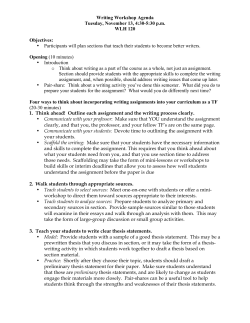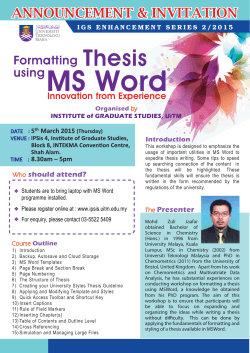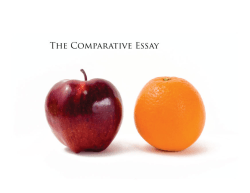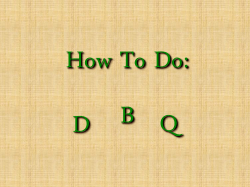
EE SFC 2015 Final Report This year, the Electrical Engineering SFC
EE SFC 2015 Final Report This year, the Electrical Engineering SFC focused on the following topics: uniting and importance of EE52 and EE44, issues with APh/EE9ab, changes associated with EE116 & EE160, the role of communication classes, thesis versus project tracks for seniors, the necessity of encouraging electives, ideas for seminar classes, and some general comments about the EE curriculum. We will briefly discuss each of these topics sequentially. EE44 & EE52 The EE undergrad curriculum has currently placed EE44, often taken first term sophomore year, as a 9 unit class. We propose to change this to 12 units; this was supported by 75% of the undergraduates who participated in our curriculum survey. Professor Hajimiri also agreed that this was a good idea. We also addressed EE52 and the new twoterm option available for students. Although this increases the overall uniting for the EE major, most student (82% of the people who took our survey) agreed that EE52 should remain 2 terms. Students stated that PCB design is especially useful, and can only be done if the 2 term curriculum is adopted. They also mentioned that the 2 term uniting was far more reasonable than the 12 units allotted to the 1 term version of EE52. APh/EE9ab As freshman with little to no knowledge of electrical engineering, we believe that APh/EE9ab is an ineffective and misleading introduction to the option. To address the issue of poor teaching quality and lack of objective in APh/EE9ab, we propose updating the EE option requirement by removing APh/EE9b and allowing the option of taking APh109 in place of APh/EE9a. This gives students the choice of two semiconductor/nanofabrication lab classes. Note that while APh9a will continue to fulfill the Caltech Institute “Freshman Lab” requirement, APh109 will not fulfill this institute requirement. EE116 & EE160 Students have problems with the current EE/ACM116 course. Students claim that the course is too theoretical, and that they do not get a solid understanding of the probability and stochastic processes background that is needed in EE160. To address this issue, we propose replacing the EE/ACM116 class with a new EE116 class, to be taught by EE faculty, in order to cater to EEs. This class will cover much of the curriculum of EE/ACM116 in a manner more suitable for EEs, and will also likely include the stochastic process material from the first half of EE160. To fill the place of EE160, one of two options will be implemented. Option 1: students will take a revised EE163 which combines material from the current EE160 and EE163 classes. Option 2: students will be required to take one course from a choice of: EE126, EE127, EE163, EE112, CS/EE/Ma129. Communication Classes Communication classes and their lack of effective teaching was a major focus of this year’s SFC meetings. We found that E10 and E11 do not properly prepare students; about 8% of our survey respondents who took E10 or E11 were satisfied with what the class(es). It seems that these classes require to do things rather than learn things. This reduces the effectiveness of the class. We suggested a few improvements: we could incorporate formal presentations in EE90 and/or EE91ab, suggest EEspecific sections in E10 and E11, or require preapproved topics to encourage better preparation (particularly in E10). We also considered the possibility of admitting exceptions and alternatives to the communication requirements, such as exempting students from E11 if they are taking the senior thesis track. In addition, it is our strong recommendation that E11 be taken freshman year rather than senior year. Thesis vs. Project The thesis track requires significantly more work in terms of writing and presentations. Currently, all students must take EE91, regardless of whether they intend to pursue a senior thesis or a senior project. In order to balance out the discrepancy, the communication aspect of the senior thesis should fulfill E10 and/or E11. We also discussed removing the EE91 requirement for students choosing the senior thesis to allow them to focus their attention on their research. Flowchart & Encouraging Electives There is a concern with the pattern of classes EE undergrads are taking: few students explore classes beyond the popular few. There is an overwhelming lack of diversity in elective choice, and very little publicity of the less popular electives. We, in turn, notice a positive feedback for popular and unpopular electives and their enrollment patterns. We suggested making a flowchart for student to show all possible tracks, which will also advertise electives outside of the select popular choices. Professors and upperclassmen can help publicize future courses. Options to turn this into action include having the IEEE club host events to publicize courses, or having faculty members host informal information sessions. Roundtable/Seminar Talks We would like to encourage studentfaculty interaction through informal seminars and discussions during lunch. It would expose EE undergraduates to the diversity of topics within EE and encourage them to pursue research or further coursework in those topics. We hope to use the IST Lunch Bunch as a model for these seminars. General Discussion & Comments In general, we see issues with the pacing of courses and course load per term. Classes are often fastpaced, and students get overwhelmed with not only the speed and workload of any one of their classes, but also the sheer number of classes that are suggested. We also looked at the idea of flipped classroom style teaching, which Prof. Yasser incorporates in his EE/CS156a class. This class has generally very positive feedback, and some professors could consider experimenting with this style of teaching to focus classroom time on interacting with students rather than just lecturing.
© Copyright 2025











